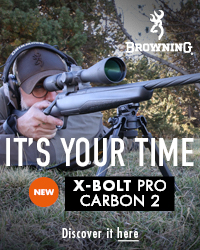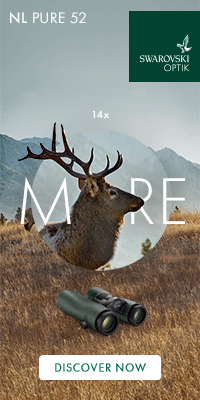African Professional Hunter Giles Allcock looks at his perfect hunting rifle and calibre combination for hunting dangerous game.
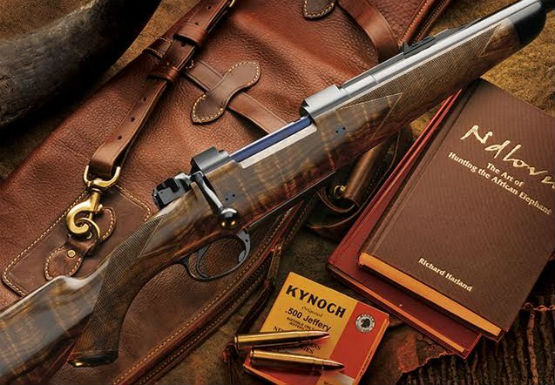
(Bolt action Hunting Rifle or Double rifle?)
We have previously discussed the perfect hunting rifle for plains game hunting, in this article I provide an insight into the caliber and rifle choice for something that is closer to my heart, the dangerous game hunt. Dangerous Game Hunting is the true sportsman’s challenge and provides a level of thrill and excitement that can only be achieved by pursuing an activity that puts you in fear of your life.
There’s no better way to liven up any conversation about guns and hunting than to bring up the subject of dangerous game rifles and calibers. Over the years I’ve hunted there has been no greater subject around a camp fire or dining room table, with either PH’s or clients alike and I have been involved in countless discussions and heated arguments regarding dangerous game rifles and the most suitable caliber to use.
 It is natural, therefore, for me to have formed my own opinions based on the distillation of my own experiences, along with the opinions of respected professionals that I have the privilege to work alongside.
It is natural, therefore, for me to have formed my own opinions based on the distillation of my own experiences, along with the opinions of respected professionals that I have the privilege to work alongside.
(To hunt dangerous game with a double rifle is simply the height of panache!)
I suppose the argument about the best rifle type – bolt-action rifle vs. double rifle – is the most discussed sub-topic, and like all the other perspectives, it’s mostly subjective.
I’m sure you are all familiar with the question this subject poses – Is it better to have the two instantly available shots that the double rifle offers or a magazine fed bolt-action rifle where you have three – or in the case of a dropped box, four back-up rounds?
The case made for the double rifle is that, in effect, you have two separate guns with two independent fire control systems, so the chances of both becoming inoperative at any given moment is remote. And to get off that instant follow-up shot all one has to do is switch triggers.
With a bolt-action rifle, on the other hand, we have four shots at our disposal, but it requires manipulating the bolt. Not only does that take 2 to 3 seconds, but it is a far from an infallible operation, particularly in a panic situation where you have a buffalo, lion or Elephant bearing down on top of you. I’ve seen many highly excited hunters panic and mess up trying to cycle a bolt-action rifle, especially when trying it with the rifle shouldered, as it should be.
Even with the extra couple of seconds it takes to lower the gun to the port arms position to cycle the bolt as most hunters do, it doesn’t always work. So with a bolt-action rifle you may have twice as many rounds at your disposal, but then again, maybe not. There’s no question as to which gun type is “classier and more traditional.” It’s like comparing a Honda Accord to a Lamborghini; both will get you to your desired destination, but how you get there makes all the difference.
There’s just so much romantic imagery and tradition to a double rifle, plus the fact it represents the pinnacle of gun making skills, Holland & Holland’s .700 Nitro Express being a prime example of just how well made a Double Rifle can be. To hunt dangerous game with a double rifle is simply the height of panache!
The fact that you can buy ten bolt actions for the price of a double, and an average-priced one at that, is not a legitimate criticism. It’s just the way things are.
As fancy and “traditional” as double rifles are, the fact is, probably 90 percent or more of the buffalo and elephant taken each year in Africa are with bolt-actions. Which begs the question, what features, if any, distinguish a Dangerous Game Rifle from your average game rifle other than caliber?
By far the preferred action is one that features Mauser-type controlled-round feed as discussed in the last article, Model 70 Winchester being a prime example.
Half the reason why is because they’re more reliable under adverse conditions and more forgiving when operated ineptly. Be that as it may, plenty of hunters show up each year with push-feed actions such as the Remington 700 and do just fine on dangerous game. It’s really minor technical points that separate the two systems, and in the real world they rarely come into play.
 Other desirable features are sturdy open sights, assuming you’re comfortable not having them at all and relying entirely on a scope. I’m talking a robust standing-leaf rear blade machined from steel that can withstand being banged against a Mopani tree or the steel pipes that comprise the roll bar and side rails on a typical safari car.
Other desirable features are sturdy open sights, assuming you’re comfortable not having them at all and relying entirely on a scope. I’m talking a robust standing-leaf rear blade machined from steel that can withstand being banged against a Mopani tree or the steel pipes that comprise the roll bar and side rails on a typical safari car.
With guns constantly being handed up and down from the back or cab of the car several times a day, there’s a good chance that a cheap sight will get bent or snapped off. A shallow “V” with a vertical white line, and a white bead as your front sight post, provides the fastest sight acquisition. Obviously, you want the front sight to be as indestructible as the rear, and without a hood of any sort.
Again, if there are no back-up iron sights, the comb should be of the right height for scope use, and parallel with the bore. If back-up irons are present, the comb must be of compromise height so that it’s fairly compatible with either sight plane, which will vary by at least an inch. There should also be a drop of about 3/4-inch from the point of the comb to the heel of the butt, which allows height adjustment to either sight planes by simply moving one’s face fore and aft.
Obviously, the best arrangement is to have both irons and a scope, in which case Quick Detach rings are essential. The idea is to get the scope as low as possible, so the lowest rings should be sought, and the scope itself should not have an objective bell, i.e., of scope tube diameter, either one inch or 30mm.
The lower the scope, the stronger the mount system. We’re of course talking scopes of low magnification range, such as 1.5-4.5x. There is simply no need for more power than that on a Dangerous Game Rifle.
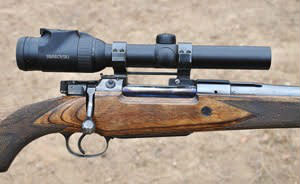 Of course, with today’s scopes having 1:5 and even 1:6 zoom ratios, you can actually have a 1-6x or 1.5-9x scope. In any case, though, the scope should not have, nor does one need, an objective bell. At the lowest power settings, there’s all the twilight performance the human eye can use. The field of view is huge, so that close-in and coming animals are easily picked up.
Of course, with today’s scopes having 1:5 and even 1:6 zoom ratios, you can actually have a 1-6x or 1.5-9x scope. In any case, though, the scope should not have, nor does one need, an objective bell. At the lowest power settings, there’s all the twilight performance the human eye can use. The field of view is huge, so that close-in and coming animals are easily picked up.
Other features favored on the Dangerous Game Rifle are a more open grip curve, which helps reduce or eliminate the bruising of the middle finger by the rear of the trigger guard, which can happen with the heaviest-recoiling calibers.
Also, because of recoil, the forward sling swivel base should be of the barrel band type rather than on the stock. However, in any kind of situation you’re likely to be, or to come into, close contact with dangerous game, having a sling on your rifle is insane.
What about barrel length? I want a short, fast-handling, fast-swinging rifle. For 21, 22 inches is as much barrel as I want, and the 60 to 75 fps I’m losing is neither here nor there, because with any suitable caliber I’m still delivering more than two tons of energy inside 50 yards.
Some PH’s believe that a 26-inch barrel is about right for a Dangerous Game Rifle, but again personal preference plays a large part in this decision. Some rationale is that the longer barrel tracks moving game better than a shorter barrel.
A large number of seasoned PH’s have hunted for decades and have infinitely more experience hunting dangerous game than I, but I have to disagree. There’s no question that the statements are correct about the tracking, but the only time a PH should be shooting is as a last resort to save his client from a life-threatening situation. That means that at short to point-blank range where a gun’s tracking characteristics on game running at a distance are meaningless.
Lastly, we come to caliber choice. Too many hunters return from their first African safari thinking they need a rifle similar to what their PH was carrying (first-time visitors are extremely impressionable!). As a PH backing up clients on dangerous game, I use a real hard stopping caliber, something with a lot of frontal area such as a .458 Lott, which I currently carry or a .505 Gibbs in bolt-action which I used to carry for many years.
My ultimate calibre for dangerous game is the .470 in a double rifle; this will stop anything, and is such a diverse caliber for dangerous game that it has always been popular with PH’s Africa wide.
But as a client, you don’t have to risk punishing calibers, not when you have a PH with you, and you’re always going to have a PH with you if you’re hunting dangerous game.
More Elephant, Rhino and Buffalo have been taken with the centuries-old .375 H&H than any other, even though it’s considered a “medium bore” in African parlance, don’t become a victim of “bigger the bore the harder they hit!”
A .375 H&H or a .416 Rigby are more than sufficient to drop any Dangerous Game Animal you choose to hunt, there is no need to spend tens of thousands to buy a rifle that will look pretty inside a locked gun cabinet, buy a rifle that you can handle and enjoy.
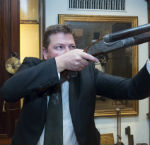 If you'd like to hunt with a reputable provider of hunting in Africa then contact the Capreolus Club on 0203 981 0159 or follow this link to find out more about this prestigous large game hunting club: capreolusclub
If you'd like to hunt with a reputable provider of hunting in Africa then contact the Capreolus Club on 0203 981 0159 or follow this link to find out more about this prestigous large game hunting club: capreolusclub
To read more about hunting rifles for deer, then simply follow this link: rifle-reviews
Or to read more about top hunting calibres, click here: rifle-calibres



